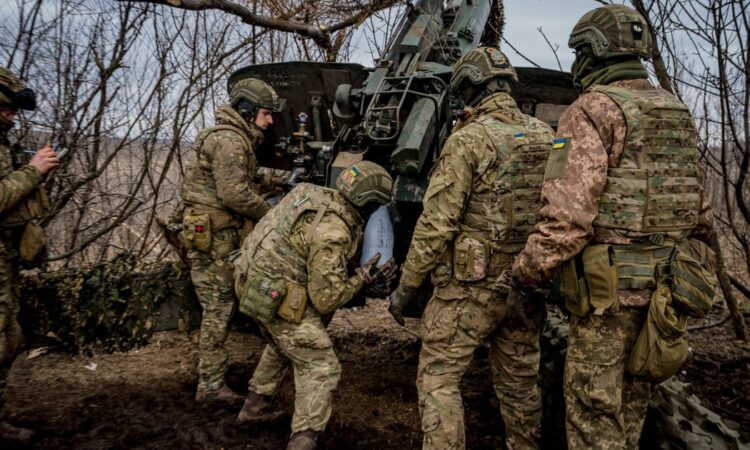
Press play to listen to this article
Voiced by artificial intelligence.
The EU is seeking countries outside the bloc to join its efforts to collectively provide ammunition, with at least Norway already expressing interest, according to one EU official and two diplomats.
The push is part of an EU plan to help provide larger quantities of lower-cost ammunition for Ukraine, while also boosting Europe’s capacity to produce and resupply its own dwindling stocks. Canada could also be included in the scheme, added a second EU official, who, like the other officials and diplomats, spoke on the condition of anonymity.
The first step, as POLITICO first reported this week, is to dedicate at least €1 billion specifically to buy 155mm artillery shells — a much-needed munition in Ukraine’s fight against Russia. In theory, the more participating countries that take part, whether they’re in or out of the EU, the easier it will be to find the money and negotiate bigger contracts.
“It makes a lot of sense,” said Kusti Salm, the permanent secretary for Estonia’s Defense Ministry. “We see that these nations are very eager to support Ukraine and join all these types of initiatives.”
Estonia was key in initiating the joint-procurement plan in recent weeks and has been advocating for it since. “Russia shoots more howitzer rounds per day than Europe as a whole can manufacture in a month,” Salm stressed.
The proposal on the table would have countries place their contributions into a collective fund, known as the European Peace Facility. The EU would then negotiate a joint ammunition contract.
The scheme is a novel use of the fund, which since the war began has been used to reimburse countries for their weapons donations to Ukraine. So far, the EU has paid countries €3.6 billion to partially cover the costs of their military aid to Kyiv.
The possibility of looping in non-EU countries to help boost the fund was first floated vaguely this past week in the EU’s blueprint for its joint purchasing plan. The document, seen by POLITICO, raised the possibility that “like-minded partners could be invited to support this effort through voluntary financial contributions.”
Now, some specifics are emerging.
“What we’re also going to try and do is to encourage some third countries to contribute,” the second EU official said. “So, we’re in discussions with the Norwegians, [and] there’s a potential interest from the Canadians.”
Yet even if the EU can source €1 billion to help buy new howitzer rounds for Ukraine, it will still be far behind Estonia’s estimate that €4 billion is needed.
According to another senior diplomat, it also remains unclear if the envisioned €1 billion would only go towards ammunition purchases or also to help boost production across Europe.
All three diplomats expressed skepticism about Canada’s potential involvement, noting it might be seen as paving the way for the U.S. to also join — an option not everyone would welcome, most notably France.
More broadly, France may represent a complicating factor in whether to bring non-EU countries into the efforts. Paris is expected to support using the pooled money for EU-made ammunition. And including Norway and Canada, which both have domestic ammunition manufacturers, may pull some of that money outside the EU’s borders.
Norway, however, does have strong links to the EU. While the country is not an EU member, it can contribute to the bloc’s collective defense fund as a member of the European Free Trade Association. A French diplomat stressed this connection, hinting that it might alleviate concerns about bringing in Oslo. The other diplomats also all said they don’t expect France to block Norway’s participation.
Norway’s defense ministry would not specifically confirm its participation in the ammo-buying scheme but said it would donate roughly €22 million to the peace facility fund. It noted in a statement that the country had also previously contributed money to support an EU military training mission for Ukraine.
Canada’s defense ministry similarly declined to confirm its involvement. Canada will host European Commission President Ursula von der Leyen early next week, when the two sides are expected to discuss support for Ukraine.
“We will continue to identify a variety of military assistance options to help Ukraine fight and win,” said Daniel Minden, spokesperson for Defense Minister Anita Anand.
According to one of the first diplomats and one other diplomat, there was also discussion this week among ambassadors about whether to seek joint purchasing assistance from the Organization for Joint Armament Cooperation, or OCCAR — a European intergovernmental organization that specializes in collaborative weapons programs.
OCCAR is almost exclusively composed of EU countries, with one notable exception: the United Kingdom.
The debate about whether to keep the ammo money within EU borders is an issue with “very polarizing views in Brussels,” said Salm, the Estonian official.
It is “a 100 percent legitimate argument that Europe needs to sustain its own manufacturing,” he added, but “we also need to make sure that there is an element that makes European industry to feel that, if they are incapable of doing this, then the money might go elsewhere.”
Suzanne Lynch and Zi-Ann Lum contributed reporting.






